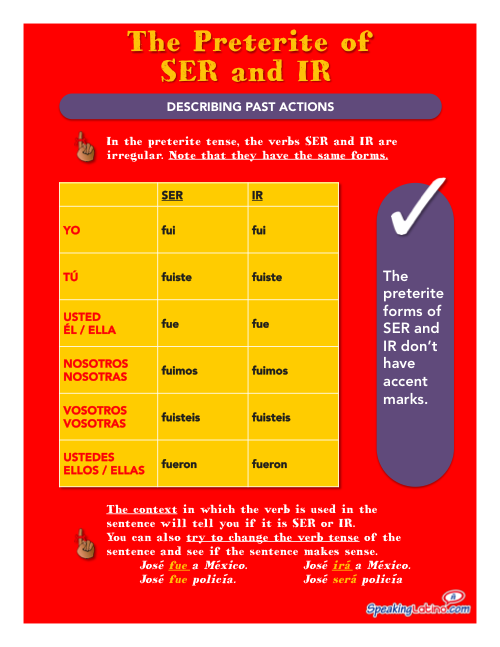Learning a new language is a journey full of exciting discoveries. As you venture into the vast world of Spanish, one of the first hurdles you’ll encounter is the intricate system of verb conjugation. While some verbs might seem straightforward, others, like “ser” and “ir,” can be perplexing for beginners. Let’s delve into the world of “ser” and “ir” and unravel the mysteries behind their usage. Imagine yourself standing at a crossroads, unsure which road to take. That’s how you might feel when confronted with the choice between “ser” and “ir.” Which verb describes being, and which one paints a picture of movement?

Image: ivuyteq.blogspot.com
“Ser” and “Ir”: A Deeper Dive
Both “ser” and “ir” are irregular verbs with distinct meanings and roles in Spanish grammar. “Ser” signifies “to be,” while “ir” means “to go.” Knowing the subtle but crucial differences between these verbs is essential for accurate and fluent communication in Spanish.
Unpacking the Meanings: “Ser” vs. “Ir”
“Ser” delves into the realm of existence, describing qualities, states of being, and permanent characteristics. It answers the question, “What is someone or something?” It’s used to express nationality, profession, origin, and even time.
On the other hand, “ir” is all about movement and direction. It describes the action of going somewhere or making a journey. It’s synonymous with “to go,” “to walk,” “to travel,” “to head,” or “to proceed.”
How to Differentiate “Ser” and “Ir”
The best way to understand the nuances between “ser” and “ir” is through examples. Let’s explore some common scenarios to illustrate their usage.

Image: arche-ele.com
“Ser” Examples:
- Yo soy estudiante. (I am a student.)
- Ella es de México. (She is from Mexico.)
- El libro es interesante. (The book is interesting.)
“Ir” Examples:
- Voy al cine. (I am going to the movies.)
- Ellos van a la escuela. (They are going to school.)
- Vamos a comer. (Let’s go eat.)
Beyond the Basics: Advanced Usage
While the fundamental meaning of “ser” and “ir” is crucial, the Spanish language offers a deeper level of understanding. These verbs often appear in idiomatic expressions and grammatical structures that enrich their usage.
“Ser” in Idioms:
- Ser de mi agrado: (To be to my liking)
- Ser un poco… (To be a bit… )
- Ser hora de… (To be time to… )
“Ir” in Grammar:
- Ir + a + infinitive: (To intend to + infinitive)
- Irse: (To leave, to go away)
- Ir + gerund: (To be in the process of + verb ing)
Tips and Expert Advice
Mastering the use of “ser” and “ir” requires practice and a conscious effort to understand their nuances. Here are some practical tips to help you conquer these verbs:
1. Pay Close Attention to Context:
The context surrounding a sentence will give you cues to choose the right verb. Look for clues about whether the sentence describes a state of being, a characteristic, or movement.
2. Understand the Question:
If you’re unsure, ask yourself if the question focuses on “what is” or “where is something going.” This can help you identify the appropriate verb.
3. Practice, Practice, Practice:
The best way to master any language skill is through practice. Utilize online resources, textbooks, and conversation exercises to solidify your understanding of “ser” and “ir.”
FAQ
Here are common questions about “ser” and “ir”:
- Q: What are the conjugations of “ser” and “ir”?
- A: The conjugation of “ser” and “ir” varies depending on the subject pronoun. Refer to a Spanish verb conjugation table for a complete overview of each conjugation.
- Q: How can I remember the difference between “ser” and “ir”?
- A: Visualize “ser” as a still picture describing what someone or something is. Picture “ir” as a moving image representing the action of going.
- Q: Are there any exceptions to the rules?
- A: Like any language, Spanish has exceptions. Certain idiomatic expressions might use “ser” or “ir” in ways that don’t seem intuitive. Consult a comprehensive Spanish grammar book to explore these exceptions.
Ser Or Ir
Conclusion
Understanding the nuances of “ser” and “ir” is a key step in your Spanish language journey. By delving into their meanings, exploring their usage in different contexts, and practicing with examples, you can confidently navigate the world of Spanish verbs.
Are you ready to put your newfound knowledge of “ser” and “ir” to the test? Let’s engage in a conversation. Tell me about something you are, or how you are going somewhere!






